How to Train an Older Dog
When you get a new dog, after the excitement of welcoming the new member of the family, whether it’s a puppy or an older dog, the first question that comes into your mind is “how do I train him or him?” (I’m gonna talk about “him” for the sake of readability, not a special preference, ok?)
Of course, if it’s a puppy, it’s very easy to teach him basic obedience and house training. But, how to train an older dog? You have always heard “you can’t teach an old dog new tricks”, but nothing can be further from the truth. The way to go about it is to approach it as you would when training the dog of any age. Most importantly is building a bond with your new pet. It’s a crucial step to be able to train him successfully. You have to develop a caring and loving relationship with him to win his trust. Talk to him, go for walks (never underestimate the importance of walking your dog, even if you have it big yard for him to play in), spend quality time together, have play sessions, etc. It’s very important to develop trust, but there also has to be mutual respect between you and your pet. It takes time to develop trust, and respect will come from defining boundaries and treating any breach with firmness and fairness. You have to develop limitations, in order to develop respect, and you need respect to develop a bond.
 Once you have built a bond with your dog, training him or teaching him anything at any age, should be doable, but more so when training an adult dog will not always be as easy as training a puppy. House training an older dog will sometimes take more time and will require a lot more love and patience on your part, especially if he was not house trained before, but it can definitely be done.
Once you have built a bond with your dog, training him or teaching him anything at any age, should be doable, but more so when training an adult dog will not always be as easy as training a puppy. House training an older dog will sometimes take more time and will require a lot more love and patience on your part, especially if he was not house trained before, but it can definitely be done.
If your dog is urinating and defecating in inappropriate places, first thing to do is rule out any medical problem. It’s always a good idea to have your new dog checked by a vet when you first adopt him. Sometimes even a diet change might do the trick. Being an adult dog, they might have a problem like incontinence, which is treatable with medications. Have a good talk with your vet about all the possible medical reasons for the behavior.
You must keep your dog in a consistent feeding schedule and remove the food one he’s done. You must also take him outside on a consistent and frequent schedule. You should take him out first thing in the morning, last thing at night, and before being confined or left alone. A fully house trained older dog should eliminate outside at least four times a day. At the beginning, know where your dog is at all times. Watch for signs that he needs to eliminate, learn to read his body language. If you see him pacing, whining, circling, or acting restless, it might mean it’s time for a potty break. If you don’t have a chance to watch him constantly, you might need to use a crate or put him in a small room with a closed baby gate or door. Take him out every few hours, and as he learns, you’ll be able to give him more liberty.
Whenever you take him out and he goes where you want him to go, praise him abundantly and even carry a tasty treat as his reward for going where he should.
What to do if you catch your dog in the act? Clap loudly or make a loud noise to startle him, but not enough to scare him. Avoid yelling or punishing him because if you do, he might decide that eliminating in your present is a bad idea, and find another place to do it. When you startle him, the dog should stop in midstream, then grab him and take him outside immediately. As you rush, do it gently and encourage him to follow you the whole way. When he finishes eliminating outside, reward him with praise and maybe a treat or two. If you find that he had an accident after the fact. Do not do anything to him since he won’t be able to connect the punishment would something he did hours or even minutes ago.
Try to control your reaction to your dog’s accidents. If you yell angrily and punish him you will jeopardize any bonding that you might have accomplished. Pet urine can be taken care of with an enzymatic cleanser designed for that purpose, it is not the end of the world.
If you can’t get your dog outside quickly enough, maybe due to his age, or mobility problems, whether yours or hers, or if you live in a high rise apartment building, consider training your dog to eliminate on pads, paper or even a dog litter box.
Spread the word about older dogs. There are magnificent adults being left behind in shelters for the very fact that people don’t know how to train an older dog and are afraid they are not trainable. They might be missing out on making a wonderful new friend.
Preparing Your Dog for a New Baby
The dogs in our lives become as much a part of the family as our children, in fact, sometimes we consider them our babies. We pamper them, play with them and spend lots of time with them. But when you are about to bring a new human to the family, you have to consider preparing your dog for a new baby and get him used to sharing the attention. You need to prepare them beforehand so they are not completely confused when the baby comes and to minimize the “sibling rivalry” that will undoubtedly develop.
One thing to avoid is to suddenly stop paying attention to your pet, scolding him, yelling, or sending him to another part of the house. That’s cruel and will only stress the dog, so you need to be mindful of how you treat your <i>first</i> baby.
If the dog is really attached to you, the new mother, it’s wise to have another member of the family start getting closer to the pet, so he or she won’t feel totally left out when you start dedicating most of your time to the new baby.
If your dog has any behavior problems, now is the time to address them with a trainer. If he play bites, swats at you or jumps on people, you need to fix these behaviors before the baby comes.
Getting the dog used to baby sounds and smells is also very useful. You can use recordings of a baby crying and use baby lotion and powder on your skin, and have your friends with babies come to your home so you can start observing your dog’s reactions to kids. Have treats ready to reward your pet and make every interaction with babies a fulfilling experience.
Another thing to do when preparing your dog for a new baby is get her used to seeing you with something in your arms, maybe a baby doll, and teach her that she cannot jump up on you. Whenever you lay the baby doll down on the sofa or the bed and the dog attempts to approach it, you need to calmly say “no”, say the dog’s name, and then say “baby”. This will condition them to the fact that they are not allowed to touch the baby.
When you bring the infant home, you will need to know how to introduce the baby to your dog. First, try to have someone take the baby to another room or hold him or her, so you can greet your dog warmly. Later, while sitting down, hold the infant securely in your arms and call the dog to you, and when introducing them, make sure you speak in a calm and loving voice. If you sound excited, the animal will also become excited, so remain calm and allow the dog to smell the infant you are holding. Let him get familiarized with the baby’s smell. Just control the interaction and see what the dog’s reaction is to the new “creature”.
Introducing dogs to babies is not hard to do because they will be naturally curious and will want to meet the new human in the house. The hard part of introducing a dog to a baby is when the dog has been the only baby in the household for a long time. They often become very jealous of the infant and they will act out to try and get your attention. They may try to take things they know belong to the infant and hide them or chew them up, and they may regress to relieving themselves indoors or doing other actions they have been trained not to do. Try to remain patient and realize it might take some time for the dog and the new baby to become friends.
Photos courtesy of:
Jacobim Mugatu
superfanstastic
yoshimov
The Most Dangerous Dogs
We can find innumerable “Top 10 Most Dangerous Dog Breeds” lists on the web, talking about what are considered the most dangerous dogs in the world. We have all heard and seen news about Pitbulls, Rottweilers, Chow Chows, Dobermans. Even some breeds we would never imagine to be dangerous have made those lists, like the Great Dane, the Dalmatian, or the Saint Bernard. Unfortunately, many of these breeds have earned this reputation, but not because “viciousness” is inherent to the breed. There are breeds that because of their strong nature, personality and temperament, have been bred by vicious owners, to fight, to attack, to be overly protective. These are dogs sought out by big “macho” types (including women) that want to get them precisely because of their reputation, and will be proud of their “vicious attack dog”.
So, if you are looking for a list of the “Top 10 Dangerous Dogs” and descriptions of particular breeds that are considered dangerous, I’ll disappoint you because I believe that all breeds can be dangerous… and all breeds can be wonderful. A Chihuahua, a Yorki or a Spaniel can be vicious if it’s in the wrong hands. Maybe their bites won’t be as bad as an Akita’s or a German Shepherd’s, but they can be aggressive and attack nonetheless.
 A feral dog, a wild dog, a street dog, can be a very dangerous dog. Sometimes they even form packs and they don’t normally fear people. They will kill for food, and they will attack humans if they feel threatened. They can also be dangerous because they might carry diseases that they can transmit to other dogs. That’s why we have to be careful when rescuing a lost dog.
A feral dog, a wild dog, a street dog, can be a very dangerous dog. Sometimes they even form packs and they don’t normally fear people. They will kill for food, and they will attack humans if they feel threatened. They can also be dangerous because they might carry diseases that they can transmit to other dogs. That’s why we have to be careful when rescuing a lost dog.
An unsocialized dog can also lack the skill to live among people and they can definitely be unpredictable. A dog that has had no love or care, and has been kept as a guard in the back yard of a house with no constant human contact and no other dogs around, can be a threat.
A scared dog will attack if it perceives that there is no escape. Their “fight or flight” response created by fear will make them either run or fight in certain situations, and if they can’t run, they will fight. This is often a problem found in stray dogs that have been out on the street for a while, but they can’t be considered feral yet.
Dogs that are kept chained up will always be more aggressive than a dog. Even a dog kept in a 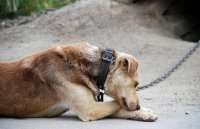 kennel is not as aggressive as a chained dog. Being bound by a chain frustrates the dog, and even the best trained animal can become highly aggressive if kept in chains.
kennel is not as aggressive as a chained dog. Being bound by a chain frustrates the dog, and even the best trained animal can become highly aggressive if kept in chains.
An untrained dog can become a danger. Any breed of dog needs to have some basic training. Even the sweetest, calmest dog can have an unexpected reaction. It’s important for the owner to know his or her animal, and that comes through bonding and training.
A hungry dog, no matter how incredibly gentle it’s always been, will become aggressive when it’s in need of nourishment. Heck, I know people that bite when they’re hungry!
A sick dog can have unusual reactions. How would you feel if someone came up to turn you around to rub your belly if you are having a terrible tooth ache?
What we need to keep in mind is that no dog is 100% safe. If a dog owner thinks this, he or she is fooling him or herself, and might be putting others in danger. Most of the time, when a dog bites somebody, you will hear the owner say “he’s never done that before”. You have to watch your dog all the time, particularly around children, until you have gotten to know him or her well enough to be trusted around familiar people. Always watch them when they approach strangers. Even a particular smell can bring out aggression in a dog without warning.
If you are planning to get a dog, please keep in mind that every breed you find in any list of dangerous dogs can make a wonderful companion, but you have to be careful about where you get it, and what its history is. If you have children, don’t adopt a grown [insert your dangerous breed here] that could have been used for fighting, or maybe kept in a chain in somebody’s backyard, or mistreated by the previous owner. If you adopt such a dog, make sure you give him or her enough training and good socialization and always be aware of its history. Many dogs rescued from dog fighting rings have proven to be wonderful pets, but you have to be a responsible dog owner and know that they can be unpredictable.
So, in closing, I would say that THE MOST DANGEROUS DOG is the one that belongs to a bad owner.
What is Heartworm Disease?
Today, pets are considered members of the family. Our dogs and cats are like our children and we have to keep up with their vet visits and general care. But if you have pets, you have to be aware of the diseases that many dogs and cats are prone to catch. One of the most awful diseases a dog, and yes, even a cat can catch, is Heartworm disease. So, what is heartworm disease?
Heartworm disease can be developed in dogs and cats that live in an environment where there are many mosquitoes. Mosquitoes carry Dirofilaria immitis, the larvae that causes this disease. If a dog or cat gets bitten by these mosquitoes, they can become victims of Heartworm disease. The larvae begin the development of the disease and are transferred directly into the pet’s skin when the mosquito bites them and feeds on their blood. As the name implies, this disease primarily affects the heart and often the lungs, even the liver. Symptoms might not appear for months after the animal’s been bitten, but when symptoms finally appear, the disease is advanced. The growing worms take residence in the heart and lung arteries and that’s when complications start. They will cause respiratory distress and finally heart failure.
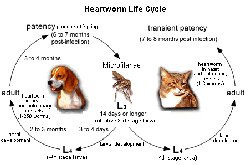 The disease is easily preventable. Owners need to be aware of the areas they leave in and medicate their pets if they’re in areas with large mosquito populations. They should give their animals Heartworm preventative drugs. The vet will check for the presence of Heartworm first, and if all’s clear, he or she will give Heartworm prevention medication. If you haven’t given these to your dog or cat and you leave in a mosquito prone area, there are specific symptoms that you can be on the lookout for. The most common signs that your pet could be affected by Heartworm disease include a decrease in overall energy level. Your pet easily gets tired and has difficulty breathing. He or she could also be coughing constantly. Look out for weight loss and a swollen belly.
The disease is easily preventable. Owners need to be aware of the areas they leave in and medicate their pets if they’re in areas with large mosquito populations. They should give their animals Heartworm preventative drugs. The vet will check for the presence of Heartworm first, and if all’s clear, he or she will give Heartworm prevention medication. If you haven’t given these to your dog or cat and you leave in a mosquito prone area, there are specific symptoms that you can be on the lookout for. The most common signs that your pet could be affected by Heartworm disease include a decrease in overall energy level. Your pet easily gets tired and has difficulty breathing. He or she could also be coughing constantly. Look out for weight loss and a swollen belly.
It’s a terrible disease and the treatment to cure it once it’s taken hold is usually very harmful to the animal. Sometimes the pet doesn’t survive the treatment itself. But you have to keep in mind that it is very preventable. It used to be that you could only find Heartworm larvae
carrying mosquitoes in southern climates, but now, it’s become a global problem. Even areas where you wouldn’t suspect the presence of mosquitoes have seen a rise in abandoned houses with unattended pools that become focuses of infection. So, why risk it? Give your pet a once a month treatment for Heartworm and avoid having to go through the nightmare of having a sick pet, and the treatment necessary to cure it.
The Incredible Wolf-Dog Hybrid
A wolfdog, or what I call the incredible wolf-dog hybrid (because I just adore wolves and dogs), is the result of a wolf and dog mix and as a matter of fact, the domestic dog has been re-categorized as a subspecies of wolf.
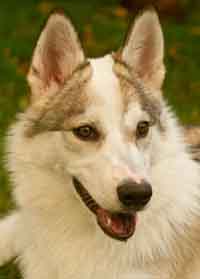 Wolfdogs have existed for thousands of years, and it’s known that they were used to hunt for mammoths in Europe. However, the first breeding of a dog with a wolf in Great Britain found on record happened in 1766, and it’s believed that a wolf mated with a Pomeranian, resulting in a litter of 9 puppies… I can only imagine how that happened, unless Poms had not been bred down to toy size yet. Nowadays, wolves are normally bred with Huskies, Malamutes and German Shepherds. The resulting hybrid is the most appealing for those who want an exotic pet and want to keep the wolf appearance. There are many wolf dog breeders around the world, and there are actually many different wolf dog hybrid breeds
Wolfdogs have existed for thousands of years, and it’s known that they were used to hunt for mammoths in Europe. However, the first breeding of a dog with a wolf in Great Britain found on record happened in 1766, and it’s believed that a wolf mated with a Pomeranian, resulting in a litter of 9 puppies… I can only imagine how that happened, unless Poms had not been bred down to toy size yet. Nowadays, wolves are normally bred with Huskies, Malamutes and German Shepherds. The resulting hybrid is the most appealing for those who want an exotic pet and want to keep the wolf appearance. There are many wolf dog breeders around the world, and there are actually many different wolf dog hybrid breeds
Many people are concerned that wolfdogs are not “safe”, but statistics show that there aren’t many instances of attacks by wolfdogs, and the ones you do find always have something to do with the mistreatment of the dogs, like having them chained or locked up in pens, thus not allowing them to be socialized. Under these conditions, it doesn’t matter what breed of dog it is, the result will eventually be an aggressive dog. The personality and disposition of the animal will depend on the way it is treated.
Although wild wolves have a lifespan of 5 to 7 years, a domesticated wolfdog can live from 15 to 20 years! They have a longer lifespan than many big dogs. They are also highly trainable. Wolfdogs are very, very smart animals and they pick up on their training at an amazing speed. They are also good with other dogs, and as with any other animal, small children should always be supervised. I personally had a wolfdog as a nanny for many years. Mishka was an incredible dog who took care of me when I was a toddler, but you have to keep in mind that large dogs will always have a prey instinct and have to be very well socialized and trained to be around small animals and children.
By nature, wolves are very shy animals and they live in packs in close family units. They are loyal, loving and caring. When you have a hybrid, he or she might have traits from either the wolf side or the dog side. 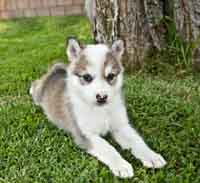 Wolfdogs can show consistently dog-like behavior, but they still retain some wolf-like behaviors like howling, digging, and chewing. A lot of chewing. They tend to be quite destructive if not trained and looked after correctly.
Wolfdogs can show consistently dog-like behavior, but they still retain some wolf-like behaviors like howling, digging, and chewing. A lot of chewing. They tend to be quite destructive if not trained and looked after correctly.
A wolfdog can be an incredibly caring and loving companion, but never lose sight of the fact that hybrids are not just regular dogs, they do have a wild wolf side, which makes them extremely intelligent, they reason and plan things out. People need to be prepared to handle them. Wolfdogs require a lot of attention. You and your family have to become a pack and give the dog all the time and attention to help him or her become a wonderful pet. If you are up for the task, and decide you want a pet wolf hybrid, you can get them from breeders, but it’s also common to find some wolf dogs for adoption
A lot of people end up giving up on their wolfdogs because they are not ready for the task, but thankfully there are places where the hybrids are given sanctuary, where they are appropriately socialized so they can find new homes.
Visit The Wolf Connection
Top Ten Friendliest Cats
I think all cat owners have made this mistake: they go to the shelter or rescue and choose the cutest cat in the bunch, without even considering its temperament or personality. Then it turns out the cat ends up not being what they expected. Some are timid, some like to be petted and others don’t, others love to play, while others will hide under the bed all day. What are the friendliest cats? When you go to the shelter or rescue, always ask the people in charge what breeds the cats they have there resemble the most. They will almost always tell you, “This one has a little Ragdoll in it, this other has a bit of Maine Coon”, and many times you will find pure breeds that have been abandoned… so keep this list of the top ten friendliest cat breeds before you go to find the most wonderful treasure you will ever have.
Click on each picture to see their wonderful qualities:
(See below for a list of picture credits)
 #10 Chantilly-Tiffany |
 #9 Somali |
 #8 Ragdoll |
 #7 Persian |
 #6 Manx |
 #5 Maine Coon |

#4
Burmese |
 #3 Birman |
 #2 Exotic Short Hair |
 #1 Abyssinian |
CLICK HERE TO SEE THE FRIENDLIEST DOGS…
Photo Credits:
Persian Cat
Top 12 Friendliest Dogs
When you decide to bring a new dog into your life, it helps to know its temperament, what’s the breed’s normal behavior, what are its characteristics, etc. Some dogs are great for kids, when some others are better suited for athletic grown ups, and yet others are better with elderly people. But, which breeds make the friendliest dogs? Some breeds are friendlier by nature than others, that’s not to say that a dog’s temperament cannot be greatly dependent on the owner’s behavior and lifestyle. It also doesn’t mean that if the breed tends to be friendly, it’s automatically an appropriate breed for all people. To help you do your homework, here’s a list of the top 12 friendliest dogs around.
Click on the pictures to learn more!
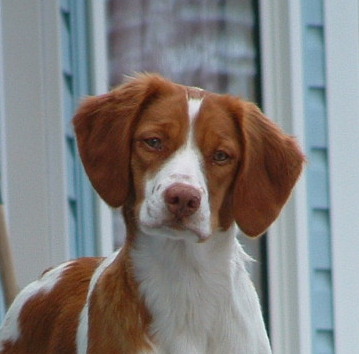 #12 #12Brittany Spaniel |
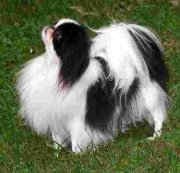 #11 #11Japanese Chin |
||||||||
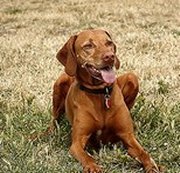 #10 #10Vizla |
 #9 #9Springer Spaniel |
||||||||
 #8 #8Cavalier King Charles |
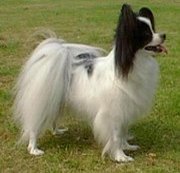 #7 #7Papillon |
||||||||
|
|||||||||
CLICK HERE TO SEE THE FRIENDLIEST CATS…
Photo credits:


 #6
#6 #5
#5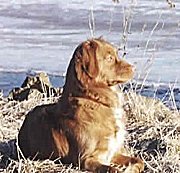

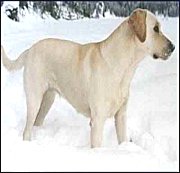 #2
#2 #1
#1